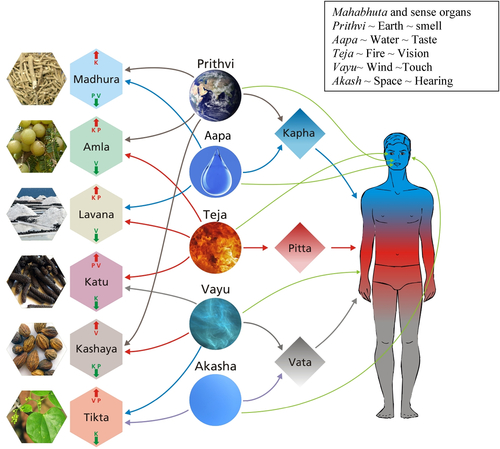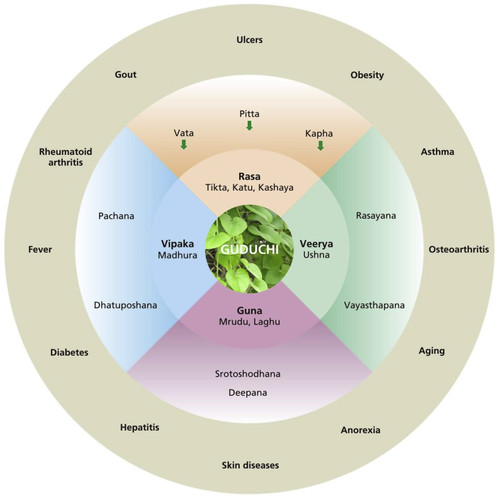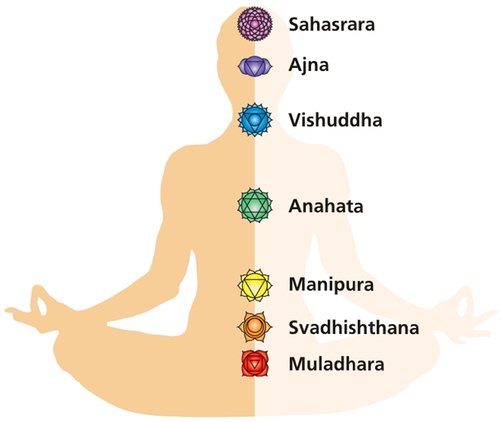Ayurveda and Yoga—A Primer
Introduction to Ayurveda
India has a unique constellation of traditional and complimentary medical practices, which include Ayurveda, Yoga, Unani, Siddha, Sowa Rigpa, and Homeopathy (AYUSH). The Ministry of AYUSH, Government of India has a formal structure to regulate quality, education, and practice involving over 785,000 registered doctors, 8500 manufacturing units, 3500 hospitals, 500 colleges admitting nearly 30,000 students every year.
Ayurveda commonly referred as “knowledge of life” is one of the ancient yet living health systems with wide acceptance especially in South Asia. Classical Ayurveda has eight main branches: internal medicine; gynecology, pediatrics; general surgery; head and neck; toxicology; mental health; rejuvenation and longevity; and reproductive health.
Charaka Samhita, Sushruta Samhita, and Ashtanga Hridaya are three main Ayurveda classics, which give descriptions of over 700 herbs and 8000 formulations. Historically, Ayurveda has been an experiential, inclusive, progressive, and continuously evolving knowledge system with universal attributes. However, its progress was stalled for thousands of years due to a series of invasions. Ayurveda still receives acceptance from the general public and its prolonged use has led to folk medicine and home remedies for common ailments.
Basic Concepts
The epistemology of Ayurveda is based on harmonious relation between microcosm and macrocosm and theory of Mahabhuta. All objects in the universe are composed of five basic elements known as Mahabhuta; appearing in living systems as dynamic principles known as three Dosha—Kapha, Pitta, Vata. Dominance of Dosha determines individual constitution known as prakriti type. Every living body is formed with seven types of tissue known as Dhatu. The waste products of metabolism such as stools, urine, and sweat are known as mala. Specific dominance of Mahabhuta also appear as six Rasa which are types of taste. Both Dosha and Rasa can influence each other (Figure A1.1).

Figure A1.1 Every substance in the Universe is formed from Mahabhuta, which manifest as Dosha in living systems and can be perceived by respective sense organs. Mahabhuta combinations can also be perceived as Rasa (taste). Each Rasa has specific effects - aggravation or alleviation of Dosha. The figure presents Mahabhuta, Rasa and their effects on Dosha.
The body has a network of channels known as Srotasa, which are responsible for free flow of nutrients and metabolites. Agni is biological fire, which is responsible for metabolic processes, digestion, absorption, and assimilation. Any undigested food can lead to toxic substances known as Ama, which is considered an important etiological factor for many diseases. Ayurvedic diagnosis known as nidana provides knowledge about pathogenesis. The six progressive stages of pathogenesis are elaborated for early diagnosis and prevention of diseases. Ayurveda classic Madhava Nidana contains over 3500 signs and symptoms and over 5000 disease types.
The principles of Ayurveda pharmacology and therapeutics are based on science of Dravya and Guna. There are 10 pairs of Guna with opposite attributes, which are used in Ayurveda therapeutics to balance Dosha (Figure A1.2).
Ayurveda knowledge base contains over 3500 herbal, animal, and mineral materials such as Dravya, which are used to prepare medicinal formulations. Figure A1.3 illustrates sophistication and multifarious effects explained by Ayurveda with the example of the herb Tinospora cordifolia (Guduchi). Over 1100 formulations of Guduchi are available for treating more than 50 diseases.
Ayurveda focus is on health protection. Detailed advice on how to remain healthy is provided in a branch known as Swasthavritta. It includes a healthy daily routine known as Dinacharya and a seasonal routine known as
Ritucharya, which describe how to align routine lifestyle in tune with nature. Many specialized drugs known as Rasayana are used for immunity and longevity. Body purification and detox procedures known as Panchakarma are used for rejuvenation and therapeutic purposes.

Figure A1.3 An example of a typical Ayurvedic drug Tinospora cordifolia (Guduchi) illustrating the relationship between the concepts of Dravya, Guna, Dosha, and Rasa, which can be used for therapeutic purposes.
An optimal healthy state is known as Swastha when a person is stable within self; when Dosha are balanced, Dhatu are well nourished, waste products are effectively removed, srotasa are clean, and Agni is active with a feeling of bliss at the levels of body, mind, and spirit. Ayurvedic therapeutics is a logical and systematic process aimed at fine tuning internal homeodynamic balance in tune with the external environment with help of natural interventions. Ayurveda offers personalized management based on individual Prakriti types.
Introduction to Yoga
Yoga literally means to integrate, to join, or to unite. It considers a person as a whole with body–mind–spirit and not in isolation. Yoga concentrates on strong immunity, which can resist several physical and psychological diseases. It suggests developing balanced behavior and stable personality with positive attitude. Yoga teaches behavioral methods for a healthy body and mind. Reducing Yoga merely as a therapy is not correct. In fact, healthy mind and body is a prerequisite for practice of Yoga.
Generally, the term Yoga is commonly used for exercises or Asana. Sanskrit lexicon describes various meanings of the term Yoga—union, addition, junction, total, way, abstract contemplation, performance, opportunity, contact, constellation, mixture, medicinal formulation, and a science of concentration and consciousness. Wordweb describes Yoga as “discipline aimed at training the consciousness for a state of perfect spiritual insight and tranquility that is achieved through the three paths of actions and knowledge and devotion.” Great sage Patanjali who authored the most authoritative classic known as Yoga Sutra, defines Yoga as capability to achieve control over a distractible mind; Bhagwad Geeta defines Yoga as dexterity in action; Yoga Vasistha another ancient classic text describes it as techniques to soften and slow down the mind. Most of the scholars agree that Yoga is a way of life and an approach toward the ultimate goal. The goal of Yoga is to be in tune with reality, consciousness finally leading to liberation of the soul through perfection. Yoga is for conditioning the mind to remain alert in a cognitive state and to be aware of the surrounding situation as well as the inner self. Buddha calls this as Nirvana, Patanjali describes it as Kaivalya, and Veda names it as Moksha. Yoga describes consciousness-based paradigm and suggests ways to get relief from tensions, stresses, diseases, and miseries for complete health.
Great philosopher, Swami Vivekananda said “Every soul is potentially divine. The goal is to manifest this divinity within by controlling external and internal environment”. Yoga suggests union of the soul with the divinity. One can attempt this goal through various ways based on individual nature, inclination, and preference. It could be through total devotion to work, or selfless worship, or meditation or a combination of any of these.
Main Types of Yoga
Yoga is Indian heritage involving physical, mental, and spiritual practice, which aims to transform body and mind. The ultimate goal of Yoga leads to Nirvana. Four major types of Yoga are mentioned in Indian classics based on the path individuals wish to choose. Raja Yoga and Hatha Yoga are more relevant for this book as they deal with meditation, posture, and breathing practices, which are useful in health promotion. Raja Yoga deals with meditation, in which the mind is trained in eight steps as described by Patanjali. Hatha Yoga is about physical techniques supplementary to a broad construct of Yoga. It concentrates on body postures (asana), breathing techniques (Pranayama), and purification procedures (shuddhi kriya). Bhakti Yoga is loving devotion to a deity. Jnana Yoga deals with the highest and continued quest for pure knowledge and understanding of nature.
Present practice of Yoga is a mix of Hatha Yoga and Raja Yoga.
Anatomical Concepts of Yoga
The anatomical concepts of Yoga are different than Ayurveda. The Atman, or soul, is considered to be covered by five layers of consciousness, or sheaths, known as Kosha (Figure A1.4). The outermost layer is known as Annamaya Kosha. Anna in Sanskrit means food. Kosha refers to physical body structure, which is dependent on nourishment from food. The next layer is known as Pranamaya Kosha. This layer is related to the vital energy force known as Prana, which is required for body functions. Next layer is Manomaya Kosha. This is a mental sheath that deals with knowledge and sense of self-existence. Next is Vidnyanamaya Kosha. This is about emotional and intellectual aspects and covers intellect and the five sense organs. Next layer is Anandmaya Kosha or sheath of bliss. This is the innermost layer on Atman. Removing this layer liberates Atman giving experience of samadhi and turya, which are the highest states of meditation. The Yoga practice helps to uncover these layers from the Atman and facilitates its liberation to experience the blissful nature of Brahman.
Another important concept of Yoga is Chakra, which is a part of the subtle (Sookshma) body (Figure A1.5). There are seven Chakra—Mooladhara (at the base of spine), Swadhisthana (in sacral bone), Manipura (at navel), Anahata (in chest), Vishuddha (in throat), Adnya (forehead), and Sahasrara (top of head). Nadi are the channels through which the life force or vital energy (Prana) moves. Several Nadi connect Chakra. The main three nadis are Sushmna (middle nadi that connects mooladhara to sahasrara chakra). Ida (right) and Pingala (left) run parallel to Sushumna and they have solar and lunar dominance, respectively. Kundalini, the supreme energy, travels from Muladhara through Sushumna. When it reaches Sahasrara, then the Yogi gets detached from the body and mind (Figure A1.6).
Therapeutic Aspects of Yoga
Yoga considers disease as a disturbance that perturbs the equilibrium. Yoga describes various preventive, promotive, therapeutic, and rehabilitative measures for several diseases. The terms kriya or karma indicate cleansing, purificatory, and reconditioning therapies. Hatha Yoga describes six processes for purification of mind and body. They have manifold effects like panchakarma of Ayurveda and are aimed at removal of toxins and noxious causative agents. These procedures are also useful for a healthy person to prepare body and mind ready for Yoga practices. These procedures are as follows:
▪ Neti—nasal cleansing using water or a soft cloth. In this technique, sterile lukewarm isotonic water is poured in one nostril, and is released from the other.
▪ Dhauti is cleaning gastrointestinal tract, respiratory tract, external ears, and eyes. It is divided in to four parts which are internal cleaning, teeth cleaning, cardiac or chest region cleaning, and rectal cleansing.
▪ Nauli is movements of abdominal muscles that clean internal organs. The procedure requires proper training and practice. It is indicated for various digestive and metabolic diseases like constipation and obesity.
▪ Basti is a procedure for cleansing the colon by sucking in either air or water.
▪ Kapalbhati is breathing with rhythmic, short, and forceful exhalations with passive inhalation. The technique is believed to clean sinus, skull, and brain.
▪ Mudra and bandha are special postures described by Hatha Yoga. They consist of certain neuromuscular locks leading to changes in internal pressures.
A classic text by sage Patanjali known as Yoga Sutra advises eight stages for liberating the soul toward samadhi for union with divinity:
1. Yama deals with morality and code of conduct. It has five components—nonviolence (at the level of body, mind, and speech), truth, honesty, and not having desire for other’s belongings and abstention.
2. Niyama is about personal conduct. It includes hygiene, contentment, self-study, asceticism, and surrender to Ishwara.
3. Asana is set of postures to retain health and preparing body and mind for breathing and meditation.
4. Pranayama is controlled breathing technique to gain control on life processes and energy or prana.
5. Pratyahara is withdrawal of senses from external objects.
6. Dharana is concentration of mind.
7. Dhyana is meditation.
8. Samadhi is the stage when the mind and the object of meditation merge together.
The philosophy and practice of Yoga requires physical and mental involvement. The learning of Yoga requires the right Guru (expert guide and mentor) who can demonstrate and correct the postures. Due to rising popularity, some components of Yoga are being repackaged, branded, and commercially propagated. Some asanas may have contraindications. For example, patients of hypertension should not undergo shirshasana and halasana. Procedures of Yoga therapies are considered safe when they are practiced with proper guidance.
Yoga deals with union of mind and body and maintaining harmony between an individual and surrounding environment. Yoga offers a path for preventive and promotive health. More than just health, it advocates a comprehensive approach toward life. Yoga way of life changes outlook, behavior and results in relaxation, balanced mind, and clarity in thought process. Yoga repackaged as different variants like mindfulness, salutogenesis, transcendental meditation, samadhi Yoga, power Yoga, kundalini Yoga, Iyengar Yoga, hot Yoga, and many such are being practiced as mind–body medicine, lifestyle medicine, and behavioral medicine. Yoga remains an attraction for practitioners and researchers due to its inclusive approach and simple, accessible, affordable,
convenient, and safe procedures. Yoga intervention can be easily integrated with any medical system. Therefore, Yoga can play a key role in future integrative medicine.
During the United Nations General Assembly in September 2014 Indian Prime Minister stated that “Yoga embodies unity of mind and body; thought and action; restraint and fulfillment; harmony between man and nature; a holistic approach to health and wellbeing.” He proposed an idea to observe World Yoga Day. This proposal received overwhelming support from 170 nations including all the countries of the European Union. As a result, starting from 2015, every 21st June will be celebrated as World Yoga Day.
Ayurveda and Yoga
Philosophies of Ayurveda and Yoga share a common perspective of the relationship between microcosm and macrocosm. Both concentrate on tuning between internal and external environments. The concepts, practices, and therapeutic approaches of Yoga and Ayurveda are complementary. Ayurveda focuses more on physical aspects; while Yoga is more about psychological, social, and spiritual dimensions of health. Ayurveda operates more at physical level with the aim to “maintain health” but Yoga drives the healthy person forward to the ultimate goal of life with a metaphysical view. Ayurveda aims at union of body, mind, senses, and soul; Yoga attempts to free the mind and experience the state of harmony and perfection.
Ayurveda has adopted the concept of mind control from Yoga.
Generally, Ayurveda operates controlling “external nature” while Yoga deals with internal nature. Controlling hunger, thirst, and evil desires is part of Ayurveda management. Yoga and Ayurveda assess effects of diet on mind in the same way in terms of satva, rajas, and tamas. However, physical health aspects of Ayurveda are elaborate as hinted by many of Yoga texts. Ayurveda suggests the modulation of pathophysiology by maintaining Dosha balance through daily and seasonal regime, lifestyle, exercise, diet, therapeutic procedures, and drugs. The special instructions about respecting natural urges are given importance. Elimination of wastes and toxic materials is another common thought between Ayurveda and Yoga. Yoga also suggests physical therapies and cleansing procedures.
Every individual has mind, which connects with senses. Ayurveda and Yoga have different concepts of mental health similar to modern psychiatry and psychology. Yoga suggests means of controlling mind through detached watchfulness toward our thoughts. Yoga suggests refraining from greed, grief, fear, anger, jealousy, attachment, and malice. Ayurveda reiterates similar concepts as sadvritta, which is code of conduct for good behavior.



